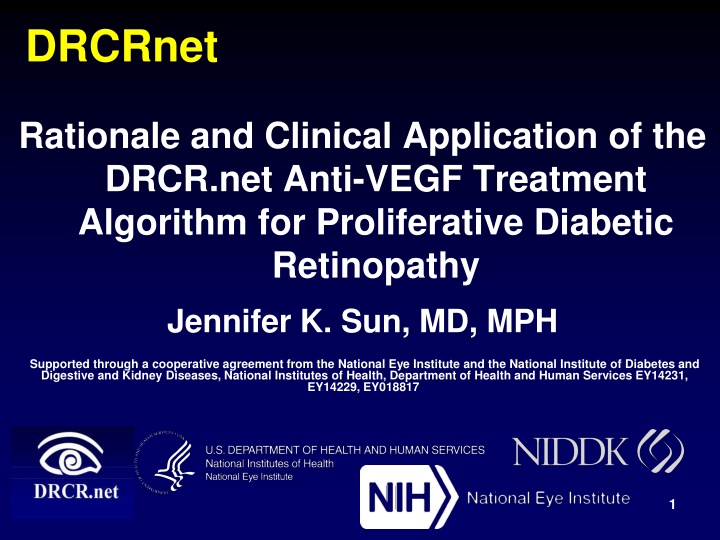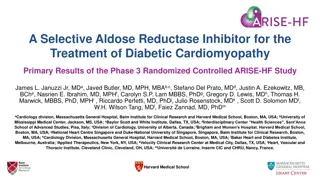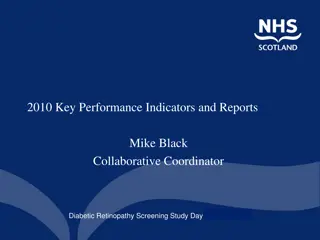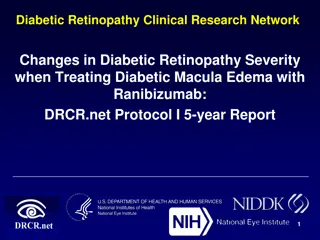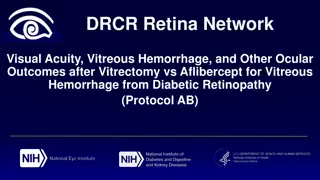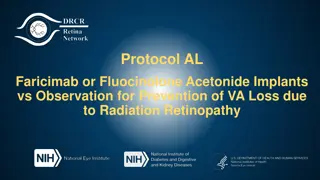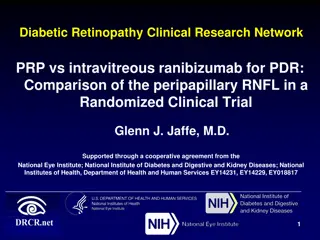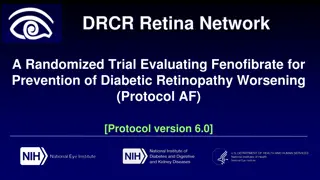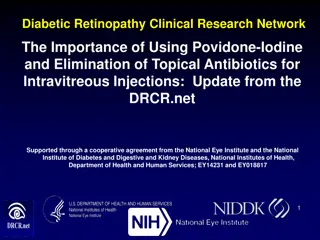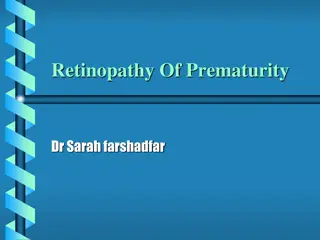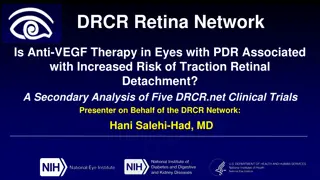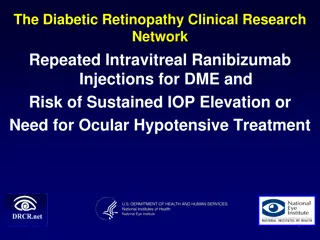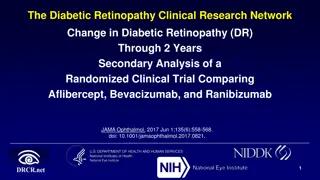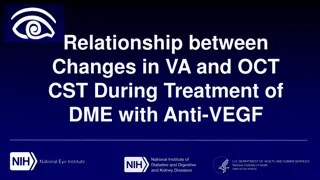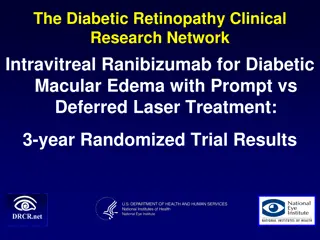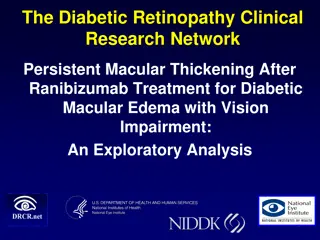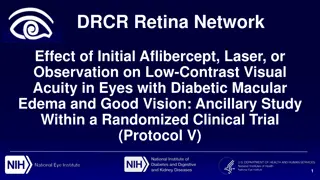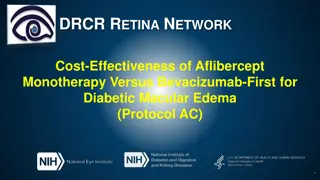DRCR.net Anti-VEGF Treatment Algorithm for Proliferative Diabetic Retinopathy
A comprehensive review of the DRCR.net Anti-VEGF treatment algorithm for managing Proliferative Diabetic Retinopathy (PDR). The protocol, frequency of injections, response assessment, retreatment, and follow-up strategies are discussed, providing valuable insights for clinicians. Procedures used to assess retinal neovascularization status and the number of injections in Ranibizumab groups are also detailed. This study offers important guidance for optimal management of PDR cases.
Download Presentation

Please find below an Image/Link to download the presentation.
The content on the website is provided AS IS for your information and personal use only. It may not be sold, licensed, or shared on other websites without obtaining consent from the author.If you encounter any issues during the download, it is possible that the publisher has removed the file from their server.
You are allowed to download the files provided on this website for personal or commercial use, subject to the condition that they are used lawfully. All files are the property of their respective owners.
The content on the website is provided AS IS for your information and personal use only. It may not be sold, licensed, or shared on other websites without obtaining consent from the author.
E N D
Presentation Transcript
DRCRnet Rationale and Clinical Application of the DRCR.net Anti-VEGF Treatment Algorithm for Proliferative Diabetic Retinopathy Jennifer K. Sun, MD, MPH Supported through a cooperative agreement from the National Eye Institute and the National Institute of Diabetes and Digestive and Kidney Diseases, National Institutes of Health, Department of Health and Human Services EY14231, EY14229, EY018817 1
Purpose Review DRCRnet anti-VEGF treatment algorithm for PDR Discuss Protocol S data that might provide guidance on managing PDR with anti-VEGF Frequency of injections given in relation to retinal neovascular status of the treated eye Time course of neovascularization response 2
Retinal Neovascularization NV of the iris, NV of the disc, and NV elsewhere* Resolved (or Success) Improved (compared with prior visit) Stable Recurrent/Worsened (compared with previous visit, vitreous or preretinal hemorrhage) Failure: NV growing and worse than baseline after 4 consecutive injections OR NVA Futility: Persistent NV after 18 months with at least 5 injections over prior 6 months *Assessment of the angle was required only if NVI was present or the eye met criteria for increased IOP, but was otherwise left to investigator discretion. Methods for evaluation of NV status were left to investigators discretion based on usual clinical practice 3
Retreatment and Follow-up With 6 Monthly Injections Exception: all NV resolved after 4 to 5 injections Start Continue unless NV is resolved or shows sustained stability (stable NV compared with last 2 injection visits) Then.. IF NV worsens after withholding injections Resume anti- VEGF
Procedures Used to Assess NV* Exams: N = 3,410 N % Extended ophthalmoscopy Undilated examination of the iris 2595 76% 904 27% Fundus Photography 471 14% Fluorescein angiography 80 2% Ultrasound 3 <1% *Participants also received slit-lamp and dilated fundus examinations at each visit. 5
Treatment: Number of Injections Ranibizumab Group Overall N = 191 Without Vision Impairing DME N = 147 With Vision Impairing DME N = 42 Median (IQR) Number of Injections 1st 6 Months 5 (4-6) 5 (4-6) 5 (4-6) 2nd 6 Months 2 (1-4) 2 (1-4) 4 (2-6) 2nd Year 3 (1-6) 3 (1-5) 5 (2-7) Total 10 (7-14) 10 (6-13) 14 (10-17) Compliance with treatment guidelines for PDR was 97% 6
Neovascularization Status by Visit At PRIOR visit: required Injections 100% 90% Neovascularization Status (%) 2% Worsened 33% Stable 16% Improved 49% Resolved 80% Failure/Futility 70% 60% Worse 50% Stable 40% Improved 30% 20% Resolved 10% 0% 4 8 12 16 20 24 28 32 36 40 44 48 52 68 84 104 % of Eyes Receiving Injections at PRIOR Visit Visit Week 7 R 99 99 98
Neovascularization Status by Visit Required unless resolved At PRIOR visit: Injections required 100% 90% Neovascularization Status (%) 8% Worsened 37% Stable 3% Improved 52% Resolved 80% Failure/Futility 70% 60% Worse 50% Stable 40% 30% Improved 20% Resolved 10% 0% 4 8 12 16 20 24 28 32 36 40 44 48 52 68 84 104 % of Eyes Receiving Injections at PRIOR Visit Visit Week 8 R 99 99 98 56 54
Neovascularization Status by Visit Required unless resolved Required unless resolved or sustained stability At PRIOR visit: Injections required 100% 90% Neovascularization Status (%) 2% Failure/Futility 27% Worsened 23% Stable 5% Improved 43% Resolved 80% Failure/Futility 70% 60% Worse 50% Stable 40% 30% Improved 20% Resolved 10% 0% 4 8 12 16 20 24 28 32 36 40 44 48 52 68 84 104 % of Eyes Receiving Injections at PRIOR Visit Visit Week 9 R 99 99 98 56 54 44 42 39 35 41 40 40 36 34 29
Injections After NV Resolution Starting at 6 Months: When NV was resolved, investigators chose to inject at 23% of the visits Median (interquartile range) number of injections between 6 months and 2 years in eyes with resolved NV at 6 months was 4 (1-7) compared with 7 (4-11) for eyes without resolved NV at 6 months (P < .001) 10
Number of Injections After Stability Stability criteria could only be met after the 6 month visit: N = 153 eyes At 6 months 37% met stability criteria 22% achieved sustained stability Investigators chose to administer treatment 15% of the time when sustained stability was met 11
Neovascularization Stability Status by Visit 100 Neovascularization Status (%) 90 80 70 60 50 40 30 20 10 0 24 28 32 36 40 44 48 52 68 84 104 Visit Week Stable Sustained Stability 12
Consecutive Visits With Injection Deferral After Sustained Stability 100% Cumulative Percentage Receiving Injection 80% 60% 40% 20% 0% 0 8 16 24 32 40 48 56 64 72 80 Weeks 13
Summary When using the DRCR.net anti-VEGF treatment algorithm for PDR: The number of injections given is reduced in the second year oMedian 7 in the first year vs 3 in the second year After the first 6 months of treatment, approximately o50% of eyes will achieve NV resolution o>30% will achieve stability o>20% will achieve sustained stability Most eyes (~90%) in which injections are withheld will need re-injection within 1 year 14
Conclusions Overall Protocol S results suggest that ranibizumab treatment for PDR following the DRCR.net algorithm is a viable alternative to PRP Using this algorithm, there is a decreasing treatment burden over the first 2 years of therapy Longer term Protocol S results are needed to determine whether stabilization of NV can be maintained chronically in eyes with PDR when anti- VEGF therapy is withheld Eyes in which injections are withheld should be watched closely for possible PDR worsening and need for re-treatment. 15
